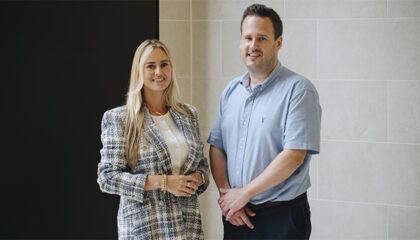Our office move delivered 95% embodied carbon savings – here’s how…
By combining our London offices into one space, and repurposing an existing unused fit-out, we’ve improved collaboration across our teams and minimised carbon impact, while creating a great workplace environment for our people to enjoy.
Our two London offices have been combined into one larger new space in the heart of the City. Located at 80 Cheapside, where the firm previously used less than half a floor, the new space spans an entire floor of the building.
At 12,227 sq. ft, the floorplate accommodates 140 people and provides a range of meeting rooms, collaborative booths, more than 100 sit/stand desks, private zoom cubicles, as well as a large kitchen area and plenty of breakout space for people to drop in between meetings.
Matthew Pateman, Managing Partner, said: “As a business, we effectively deliver two fundamental services, Property Management and Building Consultancy. The collaboration between the two respective divisions is really important and something that few of our competitors are able to offer. The new space enhances our performance and wellbeing at work – we like to see one another and speak to one another – so it provides a lot of opportunity for people to get together and collaborate. I also think that’s been one of the key strengths of the move.”
Reuse and recycle
The move not only means that Workman’s London Property Management and Building Consultancy teams can work together more efficiently; it has also delivered significant carbon savings of more than 95%. By taking over a fully fitted, but untouched floor, the firm seized the chance to reuse as much as possible; and was able to minimise its carbon footprint.
Although the fit-out was already close to perfect, there were still a few cosmetic and aesthetic changes, including signage, that needed to be made before we were able to move in.
The project was managed by Imogen Foster, an Associate in our Building Consultancy team, who completed the project in eight weeks, having taken feedback from teams and partners within the business as to what was required from the new space.
Imogen said: “Having reused an existing fit-out, we didn’t need to fit out a whole new office. We didn’t have to make any huge changes; we didn’t have to change the design or the layout. We’re using existing furniture that was already here or from our existing London offices. And anything that we’re not using is being donated to charity or being put to use in our other 10 offices across the country. It’s already fitted out with really good AV kit and meeting spaces, so we can have collaborative meetings with colleagues and clients, which works well for our teams.”
Through reuse of the existing materials at Cheapside, we kept significant amounts of material out of landfill.
Maintaining the existing layout kept 11.2 tonnes of plasterboard in use. While plasterboard is technically recyclable, most recycling schemes will only accept clean construction waste; used plasterboard from demolition therefore often ends up in landfill.
The project also kept more than 4 tonnes of carpet tiles, 5 tonnes of metal ceiling panels, and 12 tonnes of office furniture in use, which would otherwise have needed to be processed for recycling.
Analysing embodied carbon savings
Using the expertise within Workman’s ESG team, the move has been analysed through an embodied carbon assessment undertaken by Danielle Dinneen, our Sustainability Consultant and whole-life carbon analysis specialist.
Danielle said: “The findings from the embodied carbon analysis for the new office at Cheapside are very exciting. Our light-touch approach to fit out has resulted in incredibly low embodied emissions.”
In order to demonstrate the embodied carbon savings achieved through the reuse of the existing fit out and furniture, Danielle’s analysis included an additional assessment for a scenario in which the key components were completely replaced.
Embodied carbon is defined by the World Green Building Council as all the CO2 emitted from the energy used to extract and transport raw materials, as well as the emissions from manufacturing processes, installation, maintenance, and disposal. Emissions results are usually presented using the recognised metric of KgCO2e/m2 GIA (gross internal area), which allows for comparison with other projects, benchmarks and targets.
Using this metric, the carbon emissions associated with the works carried out at 80 Cheapside come to 3.4 kgCO2e per m2 of GIA, or just over 3,800kgCO2e in total. But replacement scenario results showed that a full refurbishment of the space would have meant a total carbon emission of 89,000 kgCO2e, or 78.0 kgCO2e/m2. The embodied carbon savings made through repurposing the office fit-out and furniture therefore came to more than 95%.
The most significant carbon savings at 80 Cheapside were as a result of:
- Reuse of desks, which saved more than 5 tonnes of CO2.
- Retaining the existing office layout (partitioning) saved nearly 14 tonnes of CO2.
- Retaining and reusing the existing carpet, only replacing where necessary, led to savings of more than 7 tonnes of carbon.
Operational carbon will also be streamlined
The whole building at 80 Cheapside, which is managed by Workman, is equipped with the firm’s Intelligent Building Operating System (IBOS).
The system optimises building systems to significantly reduce the operational energy and carbon emissions of occupiers, so we are confident that further operational savings can be made now that we are in occupation.



